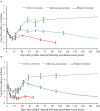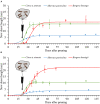Early Population Dynamics of " Candidatus Liberibacter asiaticus" in Susceptible and Resistant Genotypes After Inoculation With Infected Diaphorina citri Feeding on Young Shoots
- PMID: 34177870
- PMCID: PMC8219961
- DOI: 10.3389/fmicb.2021.683923
Early Population Dynamics of " Candidatus Liberibacter asiaticus" in Susceptible and Resistant Genotypes After Inoculation With Infected Diaphorina citri Feeding on Young Shoots
Abstract
Huanglongbing is a highly destructive citrus disease associated with "Candidatus Liberibacter asiaticus" (Las), a phloem-limited and non-culturable bacterium, naturally transmitted by the psyllid Diaphorina citri. Although diverse approaches have been used to understand the molecular mechanisms involved in the pathogen-host interaction, such approaches have focused on already infected and/or symptomatic plants, missing early events in the initial days post-inoculation. This study aimed to identify the time course of Las multiplication and whole-plant colonization immediately following inoculation by infected psyllids feeding for 2 days. Thus, the experimental approach was to track Las titers after psyllid inoculation in new shoots (NS) of Citrus × sinensis (susceptible), Murraya paniculata (partially resistant), and Bergera koenigii (fully resistant). Soon after psyllid removal, Las titers dropped until the 10-12th days in all three species. Following this, Las titers increased exponentially only in C. × sinensis and M. paniculata, indicating active bacterial multiplication. In C. × sinensis, Las reached a stationary phase at ∼5 log Las cells/g of tissue from the 40th day onward, while in M. paniculata, Las increased at a lower rate of up to ∼3 log Las cells/g of tissue between the 40th and 60th days, decreasing gradually thereafter and becoming undetectable from the 160th day onward. In B. koenigii, Las titers decreased from the start and remained undetectable. In C. × sinensis, an average of 2.6 log of Las cells/g of tissue was necessary for Las to move out of 50% of the NS in 23.6 days and to colonize the rest of the plant, causing a successful infection. Conversely, the probability of Las moving out of the NS remained below 50% in M. paniculata and zero in B. koenigii. To our knowledge, this is the first study on Las dynamics and whole-plant colonization during the earliest stages of infection. Identification of critical time-points for either successful multiplication or Las resistance may help to elucidate initial events of Las-host interactions that may be missed due to longer sampling intervals and at later stages of infection.
Keywords: Bergera koenigii; Citrus spp.; HLB; Las multiplication; Murraya paniculata; bacterial growth; qPCR.
Copyright © 2021 Alves, Cifuentes-Arenas, Raiol-Junior, Ferro and Peña.
Conflict of interest statement
The authors declare that the research was conducted in the absence of any commercial or financial relationships that could be construed as a potential conflict of interest.
Figures






Similar articles
-
Transcriptomic analysis of early stages of 'Candidatus Liberibacter asiaticus' infection in susceptible and resistant species after inoculation by Diaphorina citri feeding on young shoots.Front Plant Sci. 2025 Feb 20;16:1502953. doi: 10.3389/fpls.2025.1502953. eCollection 2025. Front Plant Sci. 2025. PMID: 40051881 Free PMC article.
-
Murraya paniculata and Swinglea glutinosa as Short-Term Transient Hosts of 'Candidatus Liberibacter asiaticus' and Implications for the Spread of Huanglongbing.Phytopathology. 2019 Dec;109(12):2064-2073. doi: 10.1094/PHYTO-06-19-0216-R. Epub 2019 Nov 4. Phytopathology. 2019. PMID: 31425000
-
Acquisition, Replication and Inoculation of Candidatus Liberibacter asiaticus following Various Acquisition Periods on Huanglongbing-Infected Citrus by Nymphs and Adults of the Asian Citrus Psyllid.PLoS One. 2016 Jul 21;11(7):e0159594. doi: 10.1371/journal.pone.0159594. eCollection 2016. PLoS One. 2016. PMID: 27441694 Free PMC article.
-
Progress and Obstacles in Culturing 'Candidatus Liberibacter asiaticus', the Bacterium Associated with Huanglongbing.Phytopathology. 2019 Jul;109(7):1092-1101. doi: 10.1094/PHYTO-02-19-0051-RVW. Epub 2019 Jun 3. Phytopathology. 2019. PMID: 30998129 Review.
-
Made for Each Other: Vector-Pathogen Interfaces in the Huanglongbing Pathosystem.Phytopathology. 2022 Jan;112(1):26-43. doi: 10.1094/PHYTO-05-21-0182-FI. Epub 2022 Jan 14. Phytopathology. 2022. PMID: 34096774 Review.
Cited by
-
Host-derived chimeric peptides clear the causative bacteria and augment host innate immunity during infection: A case study of HLB in citrus and fire blight in apple.Front Plant Sci. 2022 Dec 23;13:929478. doi: 10.3389/fpls.2022.929478. eCollection 2022. Front Plant Sci. 2022. PMID: 36618616 Free PMC article.
-
A serralysin-like protein of Candidatus Liberibacter asiaticus modulates components of the bacterial extracellular matrix.Front Microbiol. 2022 Oct 19;13:1006962. doi: 10.3389/fmicb.2022.1006962. eCollection 2022. Front Microbiol. 2022. PMID: 36338045 Free PMC article.
-
Spatial Distribution and Temporal Dynamics of Candidatus Liberibacter Asiaticus in Different Stages of Embryos, Nymphs and Adults of Diaphorina citri.Int J Mol Sci. 2023 May 19;24(10):8997. doi: 10.3390/ijms24108997. Int J Mol Sci. 2023. PMID: 37240344 Free PMC article.
-
Transcriptomic analysis of early stages of 'Candidatus Liberibacter asiaticus' infection in susceptible and resistant species after inoculation by Diaphorina citri feeding on young shoots.Front Plant Sci. 2025 Feb 20;16:1502953. doi: 10.3389/fpls.2025.1502953. eCollection 2025. Front Plant Sci. 2025. PMID: 40051881 Free PMC article.
-
'Candidatus Liberibacter brunswickensis' colonization has no effect to the early development of Solanum melongena.Sci Rep. 2024 Aug 2;14(1):17972. doi: 10.1038/s41598-024-66352-y. Sci Rep. 2024. PMID: 39095446 Free PMC article.
References
-
- Achor D. S., Etxeberria E., Wang N., Folimonova S. Y., Chung K. R., Albrigo L. G. (2010). Sequence of anatomical symptom observations in Citrus affected with Huanglongbing disease. Plant Pathol. J. 9 56–64. 10.3923/ppj.2010.56.64 - DOI
-
- Alves M. N., Lopes S. A., Raiol-Junior L. L., Wulff N. A., Girardi E. A., Ollitrault P., et al. (2021). Resistance to ‘Candidatus Liberibacter asiaticus,’ the Huanglongbing associated bacterium, in sexually and/or graft-compatible Citrus relatives. Front. Plant Sci. 11:617664. 10.3389/fpls.2020.617664 - DOI - PMC - PubMed
-
- Ammar E.-D., Ramos J. E., Hall D. G., Dawson W. O., Shatters R. G., Jr. (2016). Acquisition, replication and inoculation of Candidatus Liberibacter asiaticus following various acquisition periods on Huanglongbing-infected Citrus by nymphs and adults of the Asian Citrus Psyllid. PLoS ONE 11:e0159594. 10.1371/journal.pone.0159594 - DOI - PMC - PubMed
LinkOut - more resources
Full Text Sources
Miscellaneous

